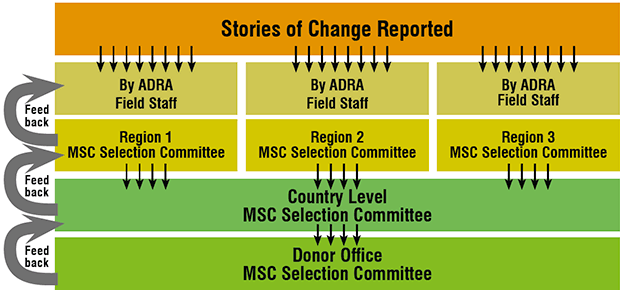The Most Significant Change technique was developed in the 1990s by Rick Davies and published in a User Guide (with Jess Dart). It is a qualitative and participatory method for recording the effects of a project or programme. Most Significant Change can be used as an ongoing monitoring tool during a project. However, the technique is especially useful for project evaluation, since it provides “data” about its outcomes and impacts. Most Significant Change is essentially based on collecting stories about significant changes – particularly from a project’s target groups – and then, via a systematic, multi-step process, selecting the Most Significant Changes. Most Significant Change is particularly suitable for complex and multi-layered projects with varied effects. It also records unexpected effects. The Most Significant Change technique, when successfully implemented, leads to whole teams focusing on the effects of their projects. Most Significant Change is thus particularly good for learning.
Implementierung
The User Guide describes the implementation of Most Significant Change in 10 steps:
- How to start and raise interest
- Defining the domains of change
- Defining the reporting period
- Collecting Significant Change stories
- Selecting the most significant of the stories
- Feeding back the results of the selection process
- Verification of the stories
- Quantification
- Secondary analysis and meta-monitoring
- Revising the system
The first step consists of involving various stakeholders and motivating them to collaborate (as the process is highly participatory). The next step is for the participants to define in which areas or on which subjects the Significant Change stories should be collected. Then they define at what intervals the stories should be collected.
The stories are collected from the people who are the most closely involved, i.e. usually beneficiaries or project staff in the field. The stories are essentially collected with the following simple question: “In your opinion, what was the most significant change for the project beneficiaries in the last three months?”
The collected stories are then filtered through the hierarchical structure of the project, programme or organisation. In concrete terms, this means that the stories are analysed and discussed at each level and eventually each level passes on one “Most Significant Story” for each subject area. Simultaneously, the selection criteria are fed back to interested stakeholders. The top level of the organisation produces a document containing the selected stories.

The next step involves verification of the selected stories during a field trip in order to establish, first of all, that they are true and, secondly, to obtain more information about the significant event. An extra step might consist of quantifying the qualitative information in the stories, e.g. with figures of how many people have experienced the same change.
The last two steps are to monitor the monitoring (e.g. Who took part and what influence did they have on the results? Which kinds of change were counted how often?) and to check the process itself (e.g. What lessons were learnt from using the technique?).
Suitability
Most Significant Change is suitable:
- When complex projects/programmes bring about multiple and varied effects;
- When unexpected changes need to be recorded as well;
- For recording the effects of large-scale programmes with a large number of organisational levels;
- For recording the effects of participatory projects/programmes focusing on social changes;
- When there is no pre-existing knowledge of monitoring and evaluation, as it is easy to communicate;
- When a detailed picture of changes is desired;
- For making a case for a project’s contribution to development;
- For learning.
Most Significant Change demands a relatively large amount of time and its effects unfold only when several rounds of selection and feedback have been carried out. It therefore makes less sense to use Most Significant Change:
- If an expected change needs confirming;
- If a completed project needs to be evaluated retrospectively;
- If an average experience of the beneficiaries needs to be ascertained;
- If there is a need for a quick and cheap evaluation for purposes of accountability.

